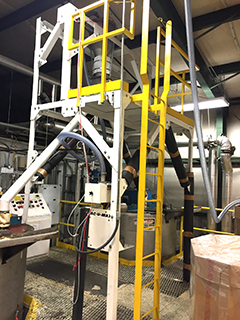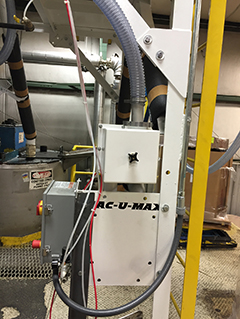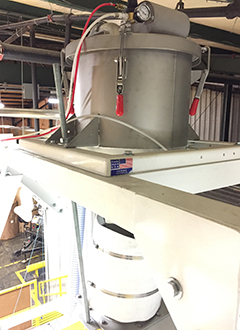Materials Handling | Pneumatic Conveyor Reduces Injuries, Cuts Waste
- Published: June 28, 2016, By Edited by Claudia Hine
International Converter adds VAC-U-MAX system to automate the transfer of wax beads into melting tanks.
A common dilemma in the industrial world is the manual transport of bulk materials, often to raised platforms where workers dump ingredients into hoppers. This arrangement presents ergonomic hazards such as exertion, repetitive motion, and awkward positions, as well as fall hazards. These ergonomic hazards can lead to work-related musculoskeletal disorders (WMSDs) that include a variety of conditions that affect the muscles, bones, and joints, and include sprains, strains, and carpel tunnel syndrome.

Although the number of WMSDs has steadily decreased since 1994, according to the Bureau of Labor Statistics, WMSDs still account for 32% of all injury and illness cases; and manual material handling is among the top three tasks incurring the highest number of WMSD cases.
Implementing engineering controls, where physical change is made to the workplace that eliminates or reduces exposure to hazards at the source, is the preferred method to control hazards according to OSHA’s hierarchy of hazard controls pyramid.
“We are always looking to improve worker safety by implementing a variety of controls and each year we generally have one large project that we can engineer the risk out of,” says Ryan Cooley, regional environmental health & safety manager for International Converter, a division of Novolex, a leader in foil laminates, multi-web lamination, and specialty barrier and sealant coatings for use in a wide range of high barrier consumer and industrial applications.
One of last year’s largest safety projects was to automate the process of transferring wax beads into melting tanks at the Iuka, MS, plant that produces products for the construction and graphics industries. The wax product is adhered to paper and used in the graphics industry as a transfer agent for transferring images onto various plastic products including food packaging.
Previously 40-lb bags containing wax beads were stacked on a pallet, lifted onto a mezzanine level above two melt tanks, where two workers would cut the ends open with utility knives and then dump the bags into heated tanks.
“It was a poorly designed process, ergonomically, to have people manually moving those 40-lb bags whenever we needed to fill a tank,” says Cooley. “So it became a priority to find another way.”
SUPPLIER SELECTION
Organizationally, it was determined that a pneumatic conveying system would be the best solution to comprehensively eliminate the risk. Pneumatic conveying systems use vacuum to gently and quickly move materials from point to point with nothing in the way to impede the efficiency of its movement. Used to convey, batch, and weigh dry materials from fine powders to plastic pellets and caps, these systems are a common solution for organizations seeking to eradicate ergonomic hazards.

When the time came to modify the process and choose a pneumatic conveyor manufacturer, Cooley contacted the Memphis, TN, office of Jim Robbins and Associates, local bulk solids and pollution control equipment experts. President Walker Robbins, who has more than 20 years of experience in the bulk solids handling industry, suggested Belleville, NJ-based VAC-U-MAX due to the manufacturers’ extensive experience with wax pellets and glue chips.
For more than 60 years, VAC-U-MAX has designed and manufactured innovative pneumatic conveyor systems and support equipment for the conveying, weighing, and batching of dry materials and is a pioneer with many industry firsts including air-powered venturi power units, direct-loading of vacuum-tolerant process equipment, and vertical-wall Tube Hopper material receivers.
“Pneumatic conveying of bulk solids is widely regarded as something of an art. The specification of systems and the selection of components tend to rely heavily on the judgment and practical experience of engineers who are familiar with the subject” according to C.R. Woodcock et al in the book titled Bulk Solids Handling: An Introduction to the Practice and Technology. This type of “tribal knowledge,” passed down through time, is what enables seasoned manufacturers to provide solutions with airtight production guarantees.
Although the process of conveying the wax chips is fairly straightforward, “there are a lot of people that wouldn’t know how to handle this type material,” says Robbins. “VAC-U-MAX has had equipment with other wax applications, so knowing what type of wax it was and knowing how it would behave was a bonus.”
Typically, the melting point of wax poses some challenges. Wax that melts at very low temperatures becomes sticky and adhesive, requiring provisions to ensure the wax melts in the tank and not in the equipment being used to convey.
In addition to the conveyor manufacturer being knowledgeable with the bulk materials’ characteristics, Robbins’ proximity and ability to communicate to the conveyor manufacturer key factors about the process and facility that could pose potential obstacles aided in designing a system that met the customer’s needs.
ENGINEERING THE SYSTEM DESIGN
For this particular application, the system design went through several iterations on the path to its final design that met the customer’s ergonomic, production, and financial needs.
Although all pneumatic conveying systems require some bit of human interaction, the first system iteration proposed the ideal solution to eliminate worker effort and risk, coming as close to a fully automated system as possible, complete with automated super sack unloading equipment and dual material receivers to facilitate the delivery of both gloss and matte wax beads to their respective tanks.
The cost however was outside of Cooley’s budget, “So we started looking at this a few different ways,” says Robbins. “That is the thing about pneumatic conveying equipment…there are numerous ways to engineer systems.”
Although the automated bulk bag unloader would have further reduced worker interaction in the process, and therefore worker risk, it did not add a whole lot to the package otherwise. On average, the company that operates three shifts five days per week transfers 1500 lbs of wax beads per shift. Had International Converter wanted to increase throughput, or had higher volumes of material to move, the bulk unloader would have been a more viable option.
Because the conveyor company manufacturers its own goods, offers ancillary components, and has tremendous amount of industry knowledge, it is able to reevaluate and redesign if equipment doesn’t meet the budget.
Robbins says the conveyor manufacturer “has seen everything. Every job you bring to them, they are like, ‘Yeah, we dealt with this in 1962.’ The tenure at the company is just incredible.”

Since the amount of pellets through the system was lower capacity, rather than using a bulk bag unloader, the manufacturer proposed that workers use a wand to suck material out of the super sack rather than suspending it. Although it is more labor intensive than using a bulk unloader, using a wand to remove material from bulk vessels eliminates the exertion, repetitive motion, and awkward positions that occurred with manual handling of 40-lb bags, and has the same outcome as using a bulk bag unloader.
In addition to backing down the automation in the system design, because the facility had high ceilings, the conveyor manufacturer was able to employ a gravity diverter valve that acts similar to a splitter valve facilitating the use of one receiver instead of two. The gravity diverter valve has a blade inside that switches from one direction to another, allowing material to be diverted to the appropriate tank.
Still on a mezzanine level, the pellets are transferred, via wand, from a Gaylord up 20 ft to the receiver. Where it used to take two workers per shift, “Now one person can do it, allowing us to utilize these employees for other tasks,” says Cooley.

To protect the conveying equipment from the heat rising from the melting tanks, a sparge ring provided some isolation from the process to the conveying equipment ensuring heat didn’t make the conveying equipment hot enough to melt the wax while conveying. Sparge rings are transition pieces with small fittings that create positive pressure and used most often with heat sensitive equipment or vapor control.
Testing the system design at the manufacturer’s facility using the customer’s product validated all assumptions and estimates before the order was placed ensuring equipment would operate on site as guaranteed.
“The pneumatic conveying system was installed this past December, and except for two days of trial and error to get the conveying cycles exact, it has worked well so far,” says Cooley. “In fact,” he says, “it even improved housekeeping and reduced product loss.”
When workers were handling the bags manually, once the ends were cut open, some of the beads inevitably ended up on the floor, contaminating the product, which could not be used in the system. With the new system, says Cooley, “Everything is enclosed, so we don’t spill the wax beads.”
Since the system is so new, Cooley hasn’t had time to accurately calculate the savings, but says, “the system has eliminated a lot of risk for us and that was the primary goal. Because this is now a one-person job, the machine is no longer shut down to load wax. The avoidance in downtime and mitigation of the risk of injury will easily pay for the system in a short period of time.”
To learn more, contact VAC-U-MAX at 69 William St., Belleville, NJ 07109; www.vac-u-max.com.




